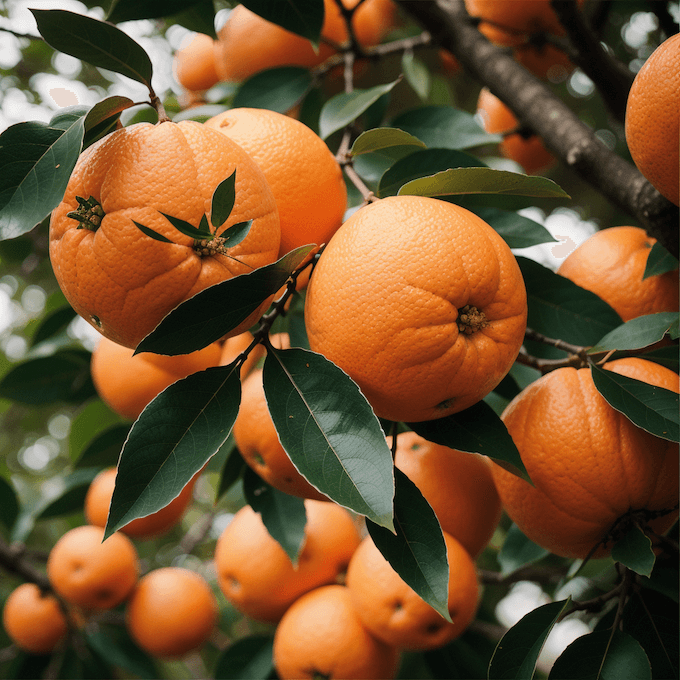Did you know that the scientific name of orange is Citrus sinensis?
This interesting fact may not seem important, but it can actually tell us a lot about this popular fruit.
The Latin name for orange is derived from the word “Sinensis,” which means “from China.”
This is because oranges were first discovered in China and later spread to other parts of the world.
So next time you’re enjoying an orange, remember that its rich history began in far-off China!
The scientific name of the orange is Citrus sinensis.

The scientific name for oranges is Citrus x sinensis.
Here 9 some key details about this name:
- Citrus indicates the genus name for all citrus species and hybrids. There are over 150 species within the Citrus genus.
- x sinensis is the specific epithet that represents sweet oranges. The “x” signifies it is a hybrid species.
- Together Citrus x sinensis forms the accepted binomial nomenclature term used in taxonomy to identify the oranges we eat.
- Oranges belong to the family Rutaceae, which contains other citrus fruits like lemons, limes, and grapefruits.
- The sweet orange originated as a cross between pomelo (Citrus maxima) and mandarin (Citrus reticulata) species.
- Other common Citrus x sinensis cultivars include blood oranges, navel oranges, and cara cara oranges.
- The scientific name Citrus x sinensis follows the standard convention of genus + specific epithet used in modern biological classification.
- It was first described by botanist Philip Miller in 1753 in his published taxonomy book The Gardeners Dictionary.
- Before this formal naming, oranges were often called “China apples” or “golden apples” dating back to ancient texts.
So in summary, the exact species name that identifies the sweet, juicy oranges found in grocery stores and used to make orange juice is Citrus x sinensis, indicating their hybrid Citrus origins.
Explain it to a child
The scientific name for orange is Citrus × Sinensis.
This comes from the Latin word ‘citrus,’ which means lemon or sour.
The addition of ‘Sinensis’ refers to the fact that oranges originally came from China.
The species is believed to be a common ancestor of modern-day oranges and other types of citrus fruit.
It is a type of citrus fruit that belongs to the Rutaceae family. Other citrus fruits in this family include grapefruits, lemons, and limes.

What is the scientific name of orange and what does it mean?
The scientific name of the orange is Citrus × Sinensis, derived from the Latin word ‘citrus’ which means lemon or sour.
The addition of ‘Sinensis’ refers to its Chinese origin, with the species believed to be a common ancestor of modern-day oranges and other unique types of citrus fruit.
In their natural state, oranges have thinner skins and fewer seeds than modern-day varieties.
It wasn’t until the 18th century that growers started cultivating more uniform varieties that we are familiar with today.
This was achieved by crossbreeding different kinds of oranges which enabled variations in color, size, and sweetness – as well as skin thickness and seed numbers – to spread across countries and cultures.
As a result, oranges are now one of the most popular fruits on offer in stores around the globe today!
Where did oranges originate from and how did they spread around the world?
The exact origin of oranges has been the subject of debate among historians and botanists for centuries, but most believe that the citrus fruit originally came from Southeast Asia.
- While it is difficult to pinpoint exactly when oranges began to spread beyond their native lands, there is evidence that by 1500 BCE, orange trees could be found in India and China.
- Around this same time, the Phoenicians began bringing oranges along trading routes as a popular form of currency.
- In the centuries that followed, oranges traveled with traders from Africa to Europe and eventually into Central America.
- By the 19th century, oranges had become so widely available and beloved around the world that they were used not just for food or currency, but for holidays and celebrations as well.

Ultimately, through cultural exchange, trade routes, and advances in agriculture, oranges made their way from Southeast Asia to every corner of the globe.
It’s true that no ship—or person—needs to take a voyage these days to sample an orange; instead, they can pop up anywhere you look!
Grocery stores are awash in tangerines and clementines almost year-round now — a testament to the global appeal this delightful fruit has acquired over time.
What is the scientific name of orange peel?
Citrus Aurantium Dulcis, or Citrus Aurantium, is the scientific name for orange peel.
- Citrus Aurantium is a member of the Citrus family, which includes fruits such as lemons, limes, grapefruit, and oranges.
- The skin of Citrus Aurantium has a distinct appearance due to its distinct ridges and coloration; it ranges from yellow-orange to burnt orange or deep red when ripe.
- The oil extracted from Citrus Aurantium has been used medicinally for centuries—it boasts antibacterial and anti-inflammatory properties that help fight numerous ailments like acne and eczema.
- While Citrus Aurantium is edible, its tough texture makes it best suited for use in perfumes and cosmetics.

That said, its zesty flavor remains popular as an ingredient in recipes like marmalades and jams.
All in all, Citrus Aurantium Dulcis truly deserves its classification as one of the most treasured members of the Citrus family!
What are some interesting facts about oranges that you may not know?
Oranges are one of the most popular citrus fruits around the world, and there’s a lot more to them than just their sweet, juicy flavor.
- To begin with, oranges are technically berries – a fact that many people do not know!
- Additionally, did you know that orange trees can actually live for up to 400 years?
- It’s also true that the juice from two oranges is usually enough to provide the daily recommended dose of vitamin C for an adult.
- In some cultures, it’s believed that carrying an orange on your person brings good luck and protection from evil spirits.
- Lastly, oranges contribute to eight percent of all worldwide agriculture use – quite impressive for such a small fruit!
These interesting facts about oranges show just how special these little fruits really are – no wonder they’ve been a favorite among humans for centuries.
So the next time you eat an orange or squeeze out some fresh orange juice, take a moment to marvel at this amazing piece of nature!
How do you say “orange” in different languages and what does it mean in those languages?
If you’ve ever wondered how to say “orange” in other languages, this article is for you!
The word for “orange” can vary widely depending on the language and culture.
In Spanish, it’s “naranja”, which comes from Sanskrit and means “fragrant”.
The Japanese say “ miin”or mikan , a term derived from an ancient Chinese dialect that implies sourness.
In German, the popular way of saying orange is “apfelsine” – literally apple-citrus.
The Russian name for orange is “apelsin” and in Greek, it’s “portokali”.
Meanwhile, in French, it’s a textbook romance with the familiar word “orange” still used today.
Going around the world, there are different opportunities to experience this delicious and vibrant fruit in many languages.
Orange has been embraced worldwide with many associations attached to it: from healthiness and joy to wealth and creativity – even envy and extremely cold temperatures have their own names involving oranges in some cultures!
It’s a great reminder of the power that words have when we can draw so many mental images all at once by simply saying them aloud.
So now when you go abroad next time, take a moment to be wowed by how this one little word can look so different among various tongues!
With all its variations it remains a unique element of speech that binds us together across cultural boundaries without barriers.
Abrenemos la puerta al mundo de los lenguajes y disfrutemos de la magia del color naranja!
(Let us open the door to the world of languages and enjoy the magic of the color orange!)
As a result, the scientific name Citrus × Sinensis is a reminder of the fascinating history of this beloved fruit.
Not only does it tell us about its origin, but it also reflects the immense diversity and abundance of oranges available today thanks to advanced agricultural techniques.
So next time you’re enjoying an orange, be sure to appreciate its rich history!
Article Sources
Jacks of Science sources the most authoritative, trustworthy, and highly recognized institutions for our article research. Learn more about our Editorial Teams process and diligence in verifying the accuracy of every article we publish.
